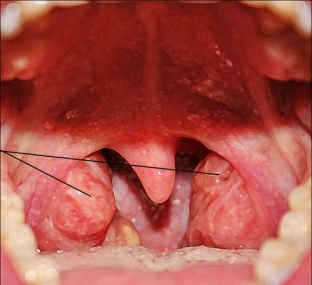Often, parents at an appointment with an otolaryngologist hear a frightening diagnosis - adenoids. Symptoms of adenoids are detected in children from 3 to 7 years old with the same frequency of lesions in both boys and girls. In adolescents over 15 years of age, adenoids are found extremely rarely. What are adenoids and why do they appear? What manifestations indicate the presence of adenoids, read in our article.
What are adenoids? Why do symptoms of adenoids appear?
Adenoids – These are pathologically enlarged tonsils in the nasopharynx. The nasopharyngeal tonsil is part of the Walder-Pirogov lymphoid pharyngeal ring. The nasopharyngeal tonsil is well developed in children, and with age it decreases or even atrophies. The reasons for the formation of adenoids include a genetic predisposition to lymphatic-hypoplastic anomalies of the constitution.
In children with symptoms of adenoids, thyroid pathology is often detected, which proves the hereditary nature of the disease. Factors that contribute to the growth of adenoids are frequent viral infections and overfeeding of the child. Secondarily, the nasopharyngeal tonsils can increase against the background of scarlet fever, measles, whooping cough and diphtheria.
Degrees of adenoid enlargement in children
There are 3 degrees of palatine tonsil enlargement depending on the symptoms of adenoids:
- 1 degree - adenoids cover the third part of the vomer and choanae. During the day, the child breathes freely, at night, in a horizontal position, nasal breathing is difficult.
- 2 degree – adenoids overlap half of the choanae and vomer in a child. At the same time, the child always breathes through his mouth and often snores in his sleep.
- 3 degree – adenoids completely or almost completely cover the choanae and vomer. Symptoms of adenoids of the 2nd degree are more pronounced.
How to determine the presence of adenoids in a child? Symptoms of adenoids
Symptoms of adenoids in a child are manifested by a constantly or periodically stuffy nose, from which a serous fluid is separated. The child sleeps with his mouth open, often snores, restless sleep. In a dream, asthma attacks are possible, provoked by the retraction of the tongue. If the adenoids are large, the voice becomes nasal. Hearing is reduced due to the overlapping of the opening of the auditory tube with adenoids. Such children become inattentive and distracted.
Against the background of adenoid growths, congestive hyperemia of the mucous membrane of the nasal concha and palate is observed. As a result of breathing problems, rhinitis develops, which turns into chronic catarrhal rhinitis. Adenoids can become inflamed, which is manifested by general non-specific signs of an infectious process with an increase in lymph nodes.

The prolonged presence of symptoms of adenoids can provoke a violation of the formation of the facial skeleton. The lower jaw is lengthened, the bite formation is disturbed due to the pathology of the hard palate. The child's face takes on an "adenoid appearance".
Violation of the breathing process also affects the formation of the chest, which takes on the appearance of "chicken breast". Most patients who have symptoms of adenoids have anemia and impaired functioning of the gastrointestinal tract (vomiting, diarrhea, constipation, nausea are often observed). Patients often cough, this process is called "adenoid cough".
Why is it important to promptly detect symptoms of adenoids in children?
The presence of symptoms of adenoids can interfere with ventilation, as breathing through the mouth does not oxygenate the lungs as much as breathing through the nose. Against this background, chronic hypoxia of the brain appears, which can provoke the development of mental fatigue. Children often complain of headaches and poor memorization of new material. In such cases, one should not be prejudiced against the patient and think about the child's desire to justify his poor academic performance.
It is very important for the health of the child to identify the symptoms of adenoids in time, as they can have complications, such as hearing loss, impaired formation of the facial skeleton and malocclusion, pathological shape of the chest.
If your child has trouble breathing through the nose, a nasal voice, and complains of poor sleep, nightmares, and poor school performance, do not put off a visit to an otolaryngologist. Based on the presence of concomitant disorders and the degree of enlargement of the adenoids, the doctor will determine the method of treatment of the adenoids.






Add a comment